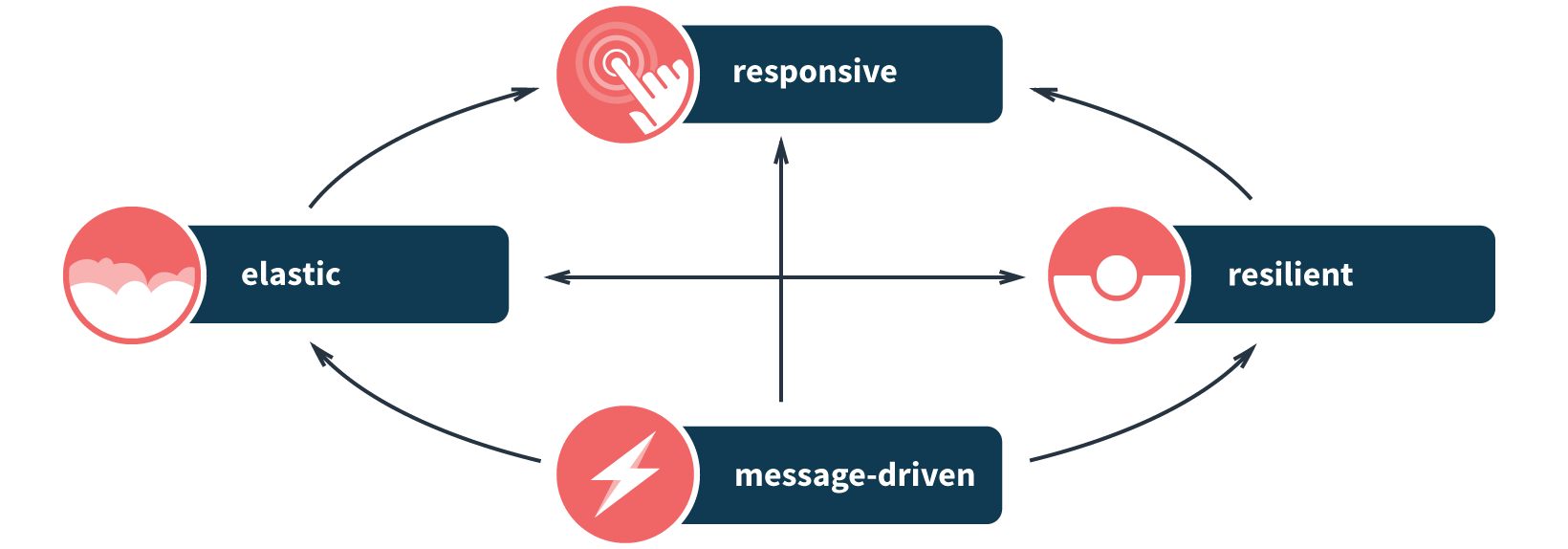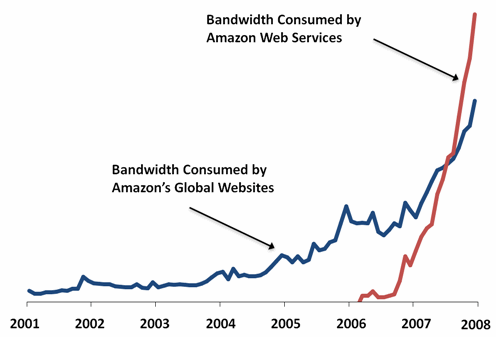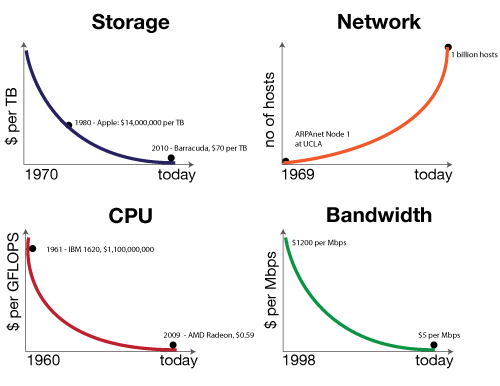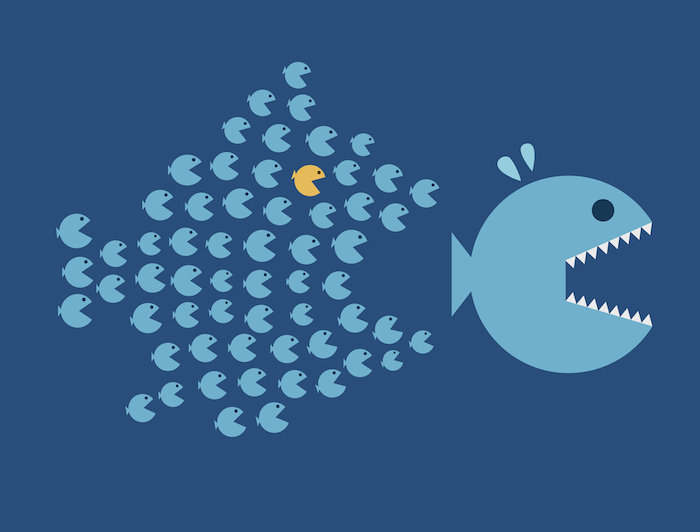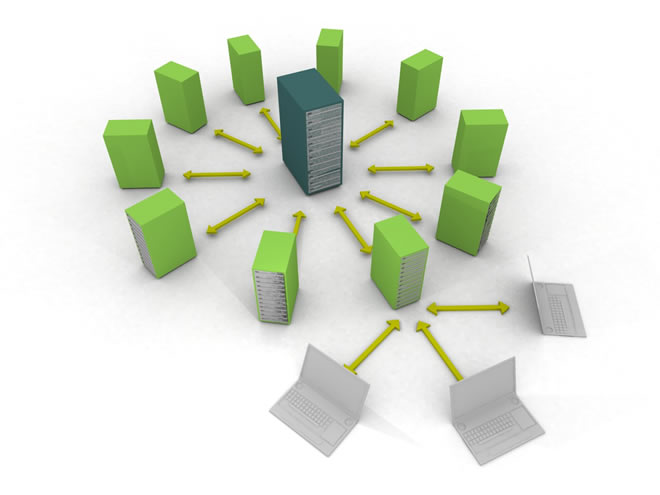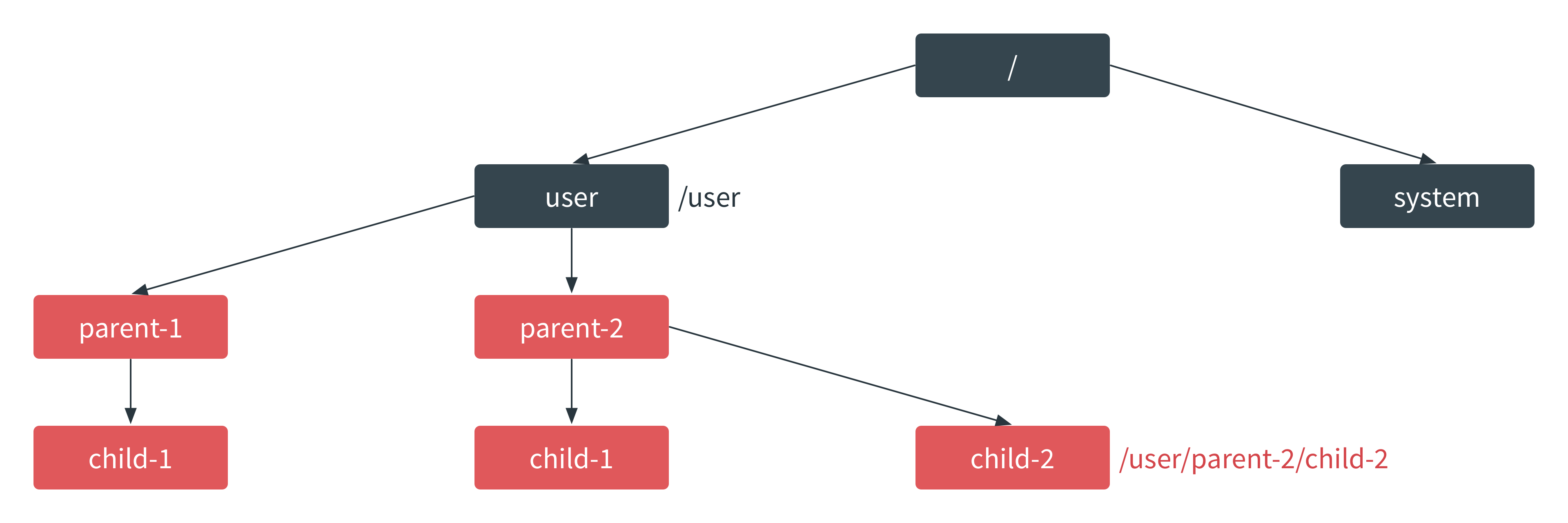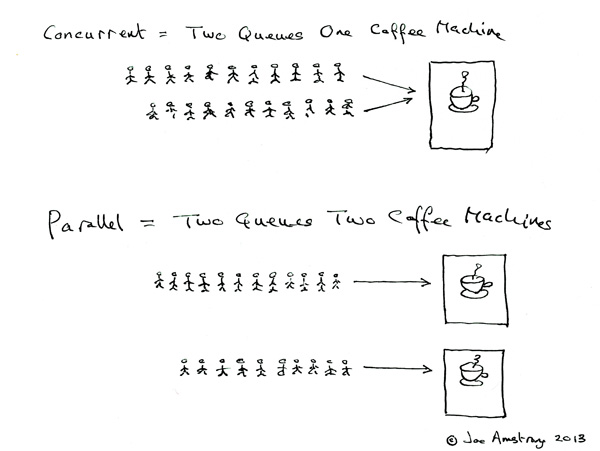footer:  Lightbend
autoscale: true
build-lists: true
Lightbend
autoscale: true
build-lists: true
- Duncan K. DeVore
- SWE @ Lightbend (Typesafe)
- Co-Author, Reactive Application Development, Manning
- What is Reactive?
- Message Driven
- Resilience
- Elasticity
One of the fascinating things found in nature is the ability of a species to adapt to its changing environment. The canonical example of this is Britain’s Peppered Moth.
When newly industrialized Great Britain became polluted in the nineteenth century, slow-growing, light-colored lichens that covered trees died and resulted in a blackening of the trees bark.
The impact of this was quite profound!
- light-colored peppered moths, camouflaged and the majority
- found themselves the obvious target of many a hungry bird
- the rare, dark ones, now blended into the polluted ecosystem
- as the birds, changed from eating dark to light moths
- the dynamics of Britain’s moth population changed
The peppered moth was able to survive due to a mutation that allowed it to react to its changing environment. This ability to react on-the-fly is what a Reactive Application. In reactive terms:
- React to load
- React to failure
- React to users
- http://www.reactivemanifesto.org/
- Published on September 16 2014. (v2.0)
- Jonas Bonér, Dave Farley, Roland Kuhn, and Martin Thompson
- 11K + Signatures
Reacting to messages: Based on asynchronous communication where the design of sender and recipient are not affected by the means of message propagation. As a result, you can design your system in isolation without worrying about how the transmission of messages occurs. Message-driven communication leads to a loosely coupled design that provides scalability, resilience and responsiveness.
Reacting to load: The system stays responsive under varying workload. Reactive applications can actively scale up and down or scale in and out based upon usage or other metrics utilized by system designers, saving money on unused computing power but most importantly ensuring the servicing of growing or spiking user base.
Reacting to failure: The system stays responsive in the face of failure. Failure is expected and embraced and since many systems exist in isolation, a single point of failure remains just that. The system responds appropriately with strategies for restarting or re-provisioning, seamless to the overall systems.
React to users: The system responds promptly if at all possible. Responsiveness is the cornerstone of usability and utility, but more than that, responsiveness means that problems may be detected quickly and dealt with effectively.
- One of the greatest impacts in the last 50 years has been The internet
- The US commissioned research to build a robust, fault-tolerant computer network
- Began with a series of memos by J.C.R. Licklider of MIT in August 1962
- Became known as the Galactic Network concept.
- He envisioned a globally interconnected network of computers
- Allow users to access data and programs from anywhere in the world.
- J.C.R. Licklider - Director @ Information Processing Techniques Office
- (IPTO) was part of the Pentagon’s ARPA, the Advanced Research Projects Agency
- Today - DARPA, the Defense Advanced Research Projects Agency
- A new computer model, Distributed Systems came into being
- It represented a shift in the computing paradigm.
- Before, the model was large, expensive mainframe systems
- Affectionately referred to as Big Iron.
- Mainframes used a centralized computing model
- Focusing on efficiency, local scalability, and reliability.
- Distributed gave way to what we know as Cloud Computing
- A more powerful less expensive computing solution
- Cloud computing represents another paradigm shift
- Changing the way we reason about computer applications
- Distributed systems focus on the technical details
- Cloud computing focuses on the economics side of the equation
As a result, many companies have begun to rethink their value proposition. Case and point:
-
In January of 2008 Amazon announced that Amazon Web Services now consume more bandwidth than their entire global network of retail services, as shown in this figure from Amazon Blogs.1
-
What is Amazon? An online bookstore or provider of Cloud Services?
This new landscape of distributed cloud computing represents a dramatic change for the modern programmer, much like the Industrial Revolution of the nineteenth century did for the Peppered moth.
Recent hardware enhancement such as multi-core CPU’s and multi-socket servers provide computing capabilities that were non-existent as little as 8 years ago. The following shows the state of storage, CPU, and bandwidth compared to the number of network nodes. Notice the increase from the 70’s!2
"In the new world, it is not the big fish which eats the small fish, it’s the fast fish which eats the slow fish." --Klaus Schwab
> "Akka is a toolkit and runtime for building highly concurrent, distributed, and fault tolerant event-driven applications on the JVM." --Akka.io
- Message Driven: System foundation for elastic, resilient responsiveness
- Elastic: System stays responsive under varying workload
- Resilient: System stays responsive in the face of failure
- Responsive: System responds in a timely manner
- Single Unified Programming Model
- simpler concurrency
- simpler distribution
- simpler fault tolerance
- single-threaded illusion
- No locks needed
- No synchronized methods
- No primitives needed
- Distributed by default
- Local to Remote by optimization
- Up == Out
- Akka decouples communication from failure handling:
- Supervisors handle failure
- Callers need not care
"The actor is the fundamental unit of computation embodying processing, storage and communication." --Carl Hewitt
- Invented 1973 by Carl Hewitt
- Processing = behavior
- Storage = state
- Everything is an actor
- Each actor has an address
Actors can
- create new actors
- send messages to other actors
- change the behavior for handling the next message
- ...
- Each actor is represented by an
ActorRef - You never get access to an
Actorinstance - An actor reference lets you send messages to the actor
- Each actor has a
mailboxand adispatcher - The
dispatcherenqueues and schedules message delivery
- Only one message at a time is passed to the actor
- Delivery/processing - separate activities may be different threads
- Actors may have mutable state:
- Akka takes care of memory consistency
- Attention: Don't share mutable state!
- Actors exclusively communicate with message passing
- Attention: Messages must be immutable!
"One actor is no actor, they come in systems." --Carl Hewitt
- An actor system is a collaborating ensemble of actors
- Actors are arranged in a hierarchy:
- Actors can split up and delegate tasks to child actors
- Child actors are supervised and delegate their failure back to their parent
- Actor Systems provide shared facilities:
- Factory for top-level actors: actorOf
- Dispatchers and thread pools: heavyweight
- Scheduling service: scheduler
- Access to configuration: settings.config
- Publish-subscribe eventStream:
- Used internally for logging,
- Unhandled messages and dead letters, but open for user code
- There can be multiple actor systems per JVM or even per classloader, because Akka doesn't use any global state
- Within an actor system actors are arranged in a hierarchy
- Therefore each actor has a parent
- Top-level actors are children of the guardian
- Each actor can create child actors
- Each actor has a name which is unique amongst its siblings
public class CoffeeHouse extends AbstractLoggingActor{
public CoffeeHouse() {
log().debug("{} has opened!", "Coffee House")
log().error(exception, "Bar closed!")
// TODO Define behavior
}
}- To implement an actor extend with
AbstractActorclass - To use Akka's logging facility extend with
AbstractLoggingActorclass
public class CoffeeHouse extends AbstractLoggingActor{
public CoffeeHouse() {
receive(ReceiveBuilder.
matchAny(o -> log().info("Coffee Brewing"))
.build()
);
}
}- Behavior is simply a
PartialFunction<Object, BoxedUnit>:- An actor can but need not handle any message
ReceiveBuilderis used for building the partial function.- The
receivemethod takes in the actor's initial behavior:- The behavior can be changed at runtime (more to come later)
final ActorSystem system = ActorSystem.create("my-system");
...
system.terminate()- To create an actor system call the
ActorSystemfactory method - Attention: As an actor system is heavyweight, don't forget to terminate the actor system "at the end"!
system.actorOf(CoffeeHouse.props(), "coffee-house");- To create an actor's you need
Props:Propsconfigure an actor, most notably its class- To create
Propsuse one of its factory methods
- To create an actor call the
actorOfmethod of anActorRefFactory:- This prevents you from accessing an actor directly
- The optional name must not be empty or start with
'$'
public class CoffeeHouse extends AbstractLoggingActor{
public static Props props(){
return Props.create(CoffeeHouse.class, CoffeeHouse::new);
}
...- You could create
Propsin place when needed. - For remoting
Propsneed to be serializable. - Best practice: Define props as a static factory method inside the corresponding actor.
ActorRef coffeeHouse = createCoffeeHouse();
protected ActorRef createCoffeeHouse(){
return system.actorOf(CoffeeHouse.props(), "coffee-house");
}- To create a top-level actor call
ActorSystem.actorOf - If you give a name, it has to be unique amongst its siblings
- If you create an anonymous actor, Akka synthesizes a name
- Creating an actor is an asynchronous operation
- Best practice: Use dedicated factory methods for creating top-level actors to facilitate testing
ActorRef coffeeHouse = ...
...
this.coffeeHouse.tell("Nice Coffee!", self());- To send a message to an actor, you need an actor reference
- Call its
tellmethod with any message and actor reference of the sender - Execution continues without waiting for a response in fire-and-forget manner
public class Guest extends AbstractLoggingActor{
...
public static final class CoffeeFinished{
public static final CoffeeFinished Instance =
new CoffeeFinished();
private CoffeeFinished(){
}
}
...
}- Attention: Messages must be immutable!
- Best practice:
- Use final static classes
- You must override equals, hashCode and toString if your message takes parameters
- Define the message protocol in the actor
final def tell(msg : scala.Any,
sender : akka.actor.ActorRef) : scala.Unit = {
...- You always have to send the ActorRef of the sender.
- If no sender is available use
Actor.noSender()
public class Waiter extends AbstractLoggingActor{
public Waiter(){
receive(ReceiveBuilder.
match(ServeCoffee.class, serveCoffee ->
sender().tell(new CoffeeServed(
serveCoffee.coffee), self())
).
matchAny(this::unhandled).build()
);
}
...sendergives you access to the sender of the current message- Attention:
senderis a method, don't let it leak!
abstract class AbstractActor()
extends scala.AnyRef
with akka.actor.Actor {
def getContext() : akka.actor.AbstractActorContext = {
...
}- Each actor has an ActorContext
- This provides contextual information and operations:
- Access to self and the current sender
- Access to parent and children
- Create child actors and stop actors
- Death watch, change behavior, etc. (more to come later)
abstract class ActorRef {
def forward(message: Any)(implicit context: ActorContext) = ...
...
}- forward sends a message passing along the sender from the actor context
- This way you can make an actor you are sending a message to respond to the actor you received the current message from
public class CoffeeHouse extends AbstractLoggingActor{
ActorRef guest = createGuest()
protected ActorRef createGuest(Coffee favoriteCoffee,
int caffeineLimit){
return context().actorOf(
Guest.props(waiter, favoriteCoffee,
guestFinishCoffeeDuration, caffeineLimit));
}
}- To create a child actor call ActorContext.actorOf
- Like for top-level actors you get back an ActorRef
- Best practice: Use dedicated factory methods for creating child actors to facilitate testing
- Review the source code
- Add code @ // code to create guests should go here
- Within an actor system actors are arranged in a hierarchy
- Therefore each actor has a parent
- Each actor has a name which is unique amongst its siblings
- Therefore each actor can be identified by a unique sequence of names
akka://my-system/user/ParentA/ChildA
akka.tcp://my-system@host.domain.com:5678/user/ParentA/ChildA
ActorPath path = coffeeHouse.path(); // akka://coffee-house-system/user/coffee-house
path.name() // coffee-house- An ActorPath encapsulates
- the sequence of actor names together with
- the transport protocol and
- the address of the actor system
- To obtain an actor path call path on ActorRef
- To get an actor's name call name on ActorPath
- Errors are a fact of life
- Don't worry, just let it crash
- Instead of trying to prevent failure simply handle it properly
- Akka deals with failure at the level of individual actors
- An actor fails when it throws an exception (NonFatal throwable)
- Failure can occur
- during message processing
- during initialization
- within a lifecycle hook, e.g. preStart
- How should such failure be handled?
@Override
public SupervisorStrategy supervisorStrategy() {
return new OneForOneStrategy(false, DeciderBuilder.
match(SomeException.class, e -> SupervisorStrategy.stop())
...
.build())
}- As you can see, a faulty actor doesn't bring down the whole system
- This fault tolerance is implemented through parental supervision:
- If an actor fails, its message processing is suspended,
- its children are suspended recursively – i.e. all descendants – and
- its parent has to handle the failure
- Each actor has a supervisor strategy for handling failure of child actors
- As you can see there is a default supervisor strategy in place
- Akka ships with two highly configurable supervisor strategies:
- OneForOneStrategy: Only the faulty child is affected when it fails
- AllForOneStrategy: All children are affected when one child fails
- Both are configured with a DeciderBuilder:
- Decider = PartialFunction<Throwable, Directive>
- A decider maps specific failure to one of the possible directives
- If not defined for some failure, the supervisor itself is considered faulty
- Resume: Simply resume message processing
- Restart:
- Transparently replace affected actor(s) with new instance(s)
- Then resume message processing
- Stop: Stop affected actor(s)
- Escalate: Delegate the decision to the supervisor's parent
- Like stopping, restarting and resuming are recursive operations
- In both cases, no messages get lost, except for the "faulty" message, if any
- Resuming simply resumes message processing for the faulty actor and its descendants:
- The actor state remains unchanged
- Use Resume if the state is still considered valid
- Restarting transparently replaces the affected actor(s) with new instance(s):
- Actor state and behavior get reinitialized
- Use Restart if the state is considered corrupted because of the failure
- By default all children get stopped (see the preRestart lifecycle hook)
- Any children that don't get stopped get restarted
@Override
public SupervisorStrategy supervisorStrategy() {
return new OneForOneStrategy(maxNrOfRetries, withinTimeRange,
DeciderBuilder.
match(SomeException.class, e -> SupervisorStrategy.stop())
...
.build())
}- Restarting is tried up to maxNrOfRetries times within consecutive time windows defined by withinTimeRange
- If a window has passed without reaching the retry limit, retry counting begins again for the next window
- By default withinTimeRange is Duration.Inf, i.e. there is only one window
- If you don't override supervisorStrategy, a OneForOneStrategy with the following decider is used by default:
- ActorInitializationException -> Stop
- ActorKilledException -> Stop
- DeathPactExceptions -> Stop
- Other Exceptions -> Restart
- Other Throwables -> Escalates to it's parent
- Therefore, in many cases, your actor will be restarted by default
- Review the source code
- Add code @ // implement SupervisorStrategy here
- Add code @ // override SupervisorStrategy here
- An actor processes (at most) one message at a time
- If you want to scale up, you have to use multiple actors in parallel
- Definition: Two or more tasks are concurrent, if the order in which they get executed in time is not predetermined
- In other words, concurrency introduces non-determinism
- Concurrent tasks may or may not get executed in parallel
- Hence concurrency is a more general concept than parallelism
- Concurrent programming is primarily concerned with the complexity that arises due to non-deterministic control flow
- Parallel programming aims at improving throughput and making control flow deterministic
- Concurrency is a property of the program
- Parallel execution is a property of the machine
- A router routes messages to destination actors called routees
- Depending on your needs, different routing strategies can be applied
- Routers can be used standalone or as self contained router actors
- RandomRoutingLogic
- RoundRobinRoutingLogic
- SmallestMailboxRoutingLogic
- ConsistentHashingRoutingLogic
- BroadcastRoutingLogic
- ScatterGatherFirstCompletedRoutingLogic
- TailChoppingRoutingLogic
- To write your own routing strategy, extend RoutingLogic:
- Attention: The implementation must be thread-safe!
- Akka provides two flavors of self contained router actors:
- Pool router: creates routees as child actors
- Group router: routees are provided via actor path
- Message delivery is optimized:
- Messages don't get enqueued in the mailbox of the router actor
- Instead, messages are delivered to a routee directly
- Every message sent to a router is delivered to one of its routees
- Yet the following messages are handled in a special way:
- PoisonPill is not delivered to any routee
- Kill is not delivered to any routee
- The payload of Broadcast is delivered to all routees
ActorRef router =
context().actorOf(
new RoundRobinPool(5).props(Props.create(Worker.class)),
"router2");
)
context().actorOf(FromConfig.getInstance().props(routeeProps),
"router3");- Router actors must be created programmatically
- Either use with a RouterConfig:
- FromConfig completely relies on external configuration
- Other RouterConfigs use a mix of programmatic and external configuration
- Or use the props method of a Pool or Group configuration
- Settings can be defined in configuration or programmatically:
- If both are given, configuration wins
- A pool router creates nrOfInstances child actors as routees:
- An optional resizer can dynamically adjust the number of routees
- The default supervisorStrategy escalates all failure
- A group router uses existing routees
akka {
actor {
deployment {
/top-level/child-a {
router = smallest-mailbox-pool
nr-of-instances = 4
}
/top-level/child-b {
router = round-robin-pool
resizer {
lower-bound = 1
upper-bound = 4
}
...- Review the source code
- Add config @ // # Use an externally configured
round-robinpool router - Add code @ // need import for routing from config
- Add code @ // replace with router from config
Footnotes
-
image from Amazon Blogs - http://aws.amazon.com/blogs/aws/lots-of-bits/ ↩
-
image from Oreilly Radar - http://radar.oreilly.com/2011/08/building-data-startups.html ↩
